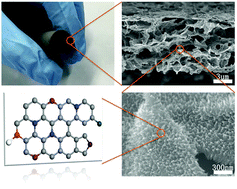A hierarchical porous N-doped carbon electrode with superior rate performance and cycling stability for flexible supercapacitors†
Abstract
A novel carbon electrode with high nitrogen content and a hierarchical porous structure has been prepared via a three-step carbonization of a three-dimensional graphene and polyaniline nanoarray composite film. The as-obtained nitrogen-doped electrodes show favorable features for flexible electrochemical energy storage, such as a hierarchical porous structure with interconnected three-dimensional (3D) pores, high flexibility and rich nitrogen-doping (9.71%). With respect to the multiple synergistic effects of these merits, a two-electrode-based supercapacitor has been fabricated. The assembled supercapacitor exhibited a high specific capacitance of 221 F g−1 at 5 mV s−1, and an excellent rate capability with a capacitance retention of 84% when the current density was varied from 3 A g−1 to 50 A g−1, and demonstrated no capacitance reduction even after 20 000 cycles of charging and discharging at 5 A g−1. Moreover, when the electrode was assembled into a flexible device, it exhibited good flexibility with 96% retention of its initial capacitance after 10 000 cycles at 5 A g−1 when the flexible device was bent to 180°. The strategy in this study represents a facile strategy for constructing well-defined 3D structures with a high nitrogen-doping content, which is promising for constructing a flexible energy storage system.



 Please wait while we load your content...
Please wait while we load your content...